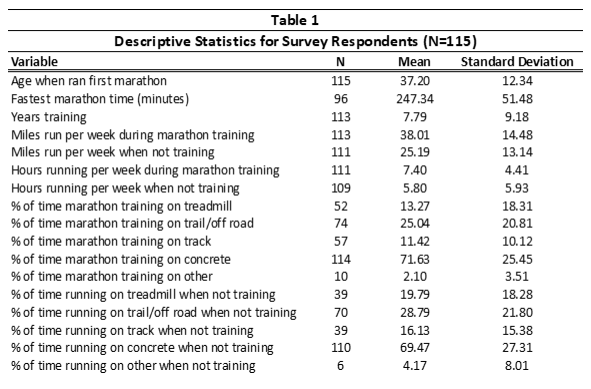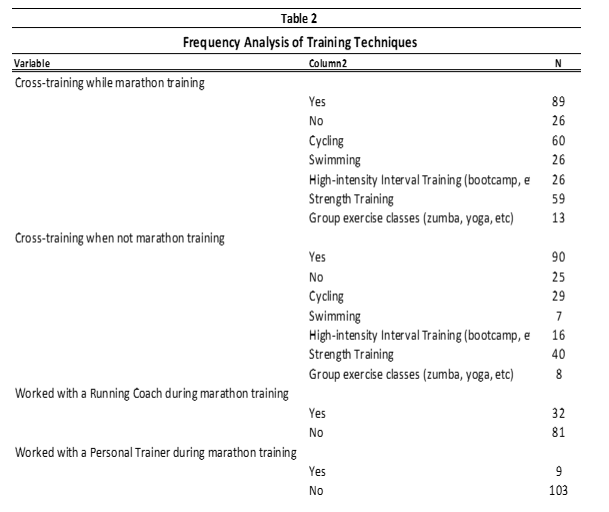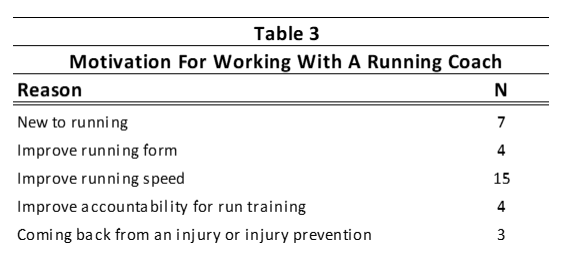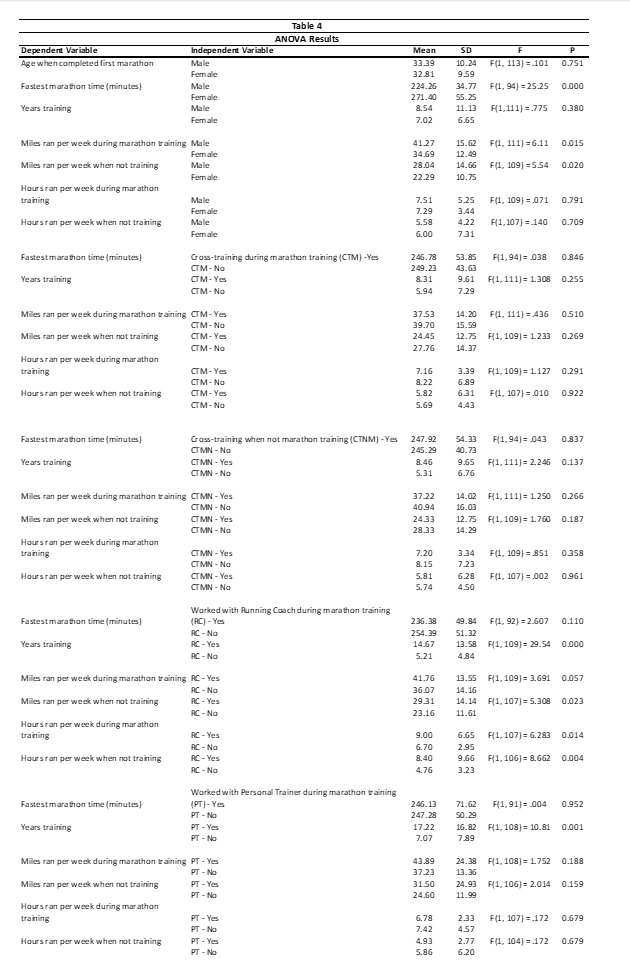Training Practices of Non-Elite Runners
Katherine Williams M.S. Oklahoma State University - Center for Health Sciences
Jennifer Volberding PhD, ATC, LAT, Associate Professor, Athletic Training Program Director Oklahoma State University Center for Health Sciences
Abstract
Marathon running has increased in the United States among non-elite marathon runners. These runners typically lack formal running training and may not realize the damage they could cause to their body with improper running techniques through long distance training. With the increase, it is probable many will seek advice from personal trainers or running coaches with regards to distance training, races and recovery. The purpose of this study was to examine the training methods of non-elite marathon runners. One hundred and fifteen participants, 58 male and 57 female (age 37.20 ± 12.34) completed a web-based survey regarding their run training practices, training surface, cross-training and if they worked with a running coach or personal trainer. Results determined that males ran faster (P= .000) and ran more miles both while training for a marathon (P = .015) and when not training for a marathon (P = .020) than women. 37 respondents worked with a running coach during marathon training with their primary motivation for doing so being to increase speed. While these findings may provide a better understanding of non-elite marathon runners and their training practices, further research should be conducted to even better understand this population. In all, this study provided an overall view of the motivations and training practices of non-elite marathon runners.
Introduction
Distance running has become an increasing trend among adults in the United States. In 1980, there were roughly 143,000 US marathon finishers and by 2009 the number had increased significantly to 467,000.1 In 2011, the number of marathon finishers was a record high of 518,000.2 With the average marathon finishing time increasing by more than 50 minutes in the recent decades, it has been attributed to non-elite or recreational runners who chose to run for reasons such as goal achievement, health, affiliation and self-esteem rather than elite competition.3 Distance training is a demanding and physical task and a runner needs the proper training program to meet the demand of distance running. Non-elite runners typically lack formal running training and may not realize the damage they could cause to their body with improper running techniques through long distance training.4
For both elite and non-elite marathon runners, regular training is required for successful marathon running.5 Frequency, intensity and volume of training seem to be of the greatest importance.6 While regular training is required for both types of athletes, elite marathoners run more kilometers per week and at a higher velocity than recreational runners.7 That being said, the frequency of training per week for non-elite marathon runners is a debatable topic between researchers and runners.
Researchers have sought to identify the training habits and the impact of the habits on elite marathon runners. While some predictor variables have been identified, discrepancies do exist on the impact of these factors. Tanda8 found that mean distance per week and the mean training pace were strongly correlated with Marathon Performance Time (MPT). Schmid et. al.9 determined that the only predictors related to marathon race time were maximal distance ran per week, the number of running training sessions per week, and the running speed of the training sessions with the running speed of the training sessions being the most important predictor. Ferreira and Rolim 10 found with elite runners, that a traditional method of training at a lower intensity (62-82%) of HeartRate Max(HRmax) with a running volume of approximately 150-200 km (94-125 miles) per week can lead to successful results for marathon runners as long as they have increased training distances over many years. However, in contrast, Barandun et. al. 11 stated they could not confirm finding an equation between training duration and marathon race time.
While most of these studies are based on elite runners and demonstrate conflicting findings on frequency, duration and intensity of training for marathon runners, more research and findings can be done to help determine what is best for non-elite marathoners. Dolgener, Kokhorst, and Witsett12 focused on non-elite runners and the minimum training distance possible to complete a marathon. Two groups of novice runners (male and female) were asked to run either four (three short runs and one long run) or six (five short runs and one long run) days a week. Unfortunately, no differences were noted between the race performances during the marathon for the two groups with both able to complete and be successful regardless of training technique.
Another area of interest in marathon running is the topic of cross-training. Cross-training can be a means for injury prevention but also for the improvement of overall fitness and health while avoiding boredom. Cross-training can be extremely helpful for marathon runners during extensive training periods to give their body a break from their normal routine by participating in another form of exercise to prevent injury as well as potentially improving running performance. Whether or not cross-training improves running performance is controversial as studies have shown improvement with certain types of cross-training while others have shown no improvement of running performance with cross-training.13 Minimal research exists on other types of cross-training, such as biking and swimming, and their affect on marathon training and race performance.
Voight, et. al.1 conducted research on non-elite Boston Marathon qualifying and non-qualifying runners and their participation in cross-training (most commonly biking and weightlifting) before the marathon, one month after and six months after the race. They found over half of participants surveyed participated in cross training before the marathon.1 The number increased to 74% one month after race and remained steady at 71% six months after the race. Resistance training has been suggested to positively impact distance running performance by adding it to the aerobic training program already in place by the runners.14 One study emphasized heavy resistance training with the leg muscles for trained and untrained participants and demonstrated improved performance in long-term and short-term endurance based off of time to exhaustion at 80% and 100% of VO2max.15
Successful marathon running may require more than just focused training techniques. With the increase in non-elite runners, it is probable that there will be an increase in these runners seeking advice from personal trainers or running coaches. Potential reasons for seeking out personal trainers or coaches are instruction on proper running techniques for optimal performance and injury prevention. Running coaches and personal trainers need to be able to assist their clients in creating training programs that are effective and safe. In all, using research on how successful runners are training for performance, coaches and trainers may better prepare their clients for distance training, races and recovery. With the limited information on non-elite marathon runners training the purpose of this study was to examine the training methods of non-elite marathon runners.
Methods
One hundred fifteen participants (58 male, 57 female, age 37.20 ± 12.34 years) completed a university human subjects approved, web-based survey. The height and weight of the participants were 68.43 ± 4.30 inches and 155.29 ± 29.26 pounds. The highest education achieved of the participants was acquired and found that the majority of the participants had a Graduate degree (49) or a Bachelor's degree (48). Twelve respondents had served or were serving in the United States Armed Forces.
Participant recruitment
Run Club Directors from Oklahoma, Texas and Arkansas were contacted and asked to forward an email with the web-based survey link and information to their running club members and information about the study and the link to the survey were posted to various forms of social media. However, due to the use of social media it was difficult to keep track of actual possible respondents reached, so a correct response rate could be calculated and therefore subject recruitment focused on total number of responses. The lack of response rate reported has been utilized in similar studies that reported numbers instead of response rate.16
Survey Development
A group of exercise scientists with experience and knowledge in marathon and cross training created the survey. Respondents to the survey provided their age, gender, height, weight, age when completed first marathon, fastest marathon time,17 highest education achieved and if they had or were currently serving in the United States Armed Forces. Questions about previous running experience and how many years and months they had been running on a regular basis (3 or more days a week) and current training programs while training for both marathon and non-marathon were included.17, 11 The following training program elements were assessed: number of running hours per week, running distance per week,1, 17, 11 and total mileage on different running surfaces (Treadmill, Trail/Offroad, Track, Concrete/Asphalt, other). To measure cross training, subjects were asked whether they included non-running activities during marathon and non-marathon training times. If the answer was "yes", then cross-training options were given (cycling, swimming, high intensity interval training, strength training or group exercise classes). The subjects were also asked how many hours a week they participated in cross-training activities.1 Additionally, they were asked if they had worked or are currently working with a Personal Trainer or Running Coach. If answered yes, respondents were asked how often the met or are meeting with a coach or trainer and also what percentage of their marathon training they met with coach or trainer. Respondents were also asked their motivation for contacting a Running Coach or Personal Trainer. To assess the percentage of where the runners obtained information related to marathon training a sliding scale percentage was given for various source options (internet, magazines, books, running store, word of mouth, running coach, fitness professional). The full survey can be shared by contacting the authors. Overall, validity of the survey was determined with a Cronbach's alpha of 0.63.
Statistical Analysis
Data from the survey was collected and entered into the SPSS 21.0 software for analysis. Means and standard deviations were calculated. Dependent variables were age during first marathon, fastest marathon time, years training, miles run a week during marathon training, miles run a week when not marathon training, hours ran per week during marathon training and hours ran per week when not marathon training. Independent variables were gender, cross-trained during marathon training, cross-trained when not marathon training, worked with a running coach and worked with a personal trainer. Multiple 1-way analyses of variance (ANOVAs) were performed for each dependent variable by each independent variable. An alpha level of .05 was utilized to determine significance.
Results
The mean and standard deviation of the age during first marathon, fastest marathon time, years training, miles ran per week when marathon training, miles ran per week when not training, hour ran per week during marathon training, hours ran per week when not marathon training as well as the percent of time ran during marathon training and when not marathon training on different surfaces can be found in Table 1.
Table 1:

Frequencies demonstrated that the majority of respondents cross-trained while marathon training (89) with their primary choice of cross-training activity being cycling (60) and or strength training (59). The respondents reported that 37 of them had worked with a running coach during their marathon training and nine had worked with a personal trainer. The full frequency distribution can be found in Table 2.
Table 2:

When asked about motivation to work with a running coach or personal trainer, the majority responded with the motivation to increase their speed during marathon training and the marathon. Other motivational factors can be found in Table 3.
Table 3

Various ANOVAs were performed to identify the differences within gender, cross-training and if the respondent worked with a run coach or trainer and compare it to their recorded survey results such as fastest time, years training, etc. Eight ANOVAs resulted in statistical significance. When making comparisons by gender, males ran faster than women (F1,94= 25.25, P= .000) and ran more miles both while training for a marathon (F1,111 = 6.11, P = .015) and when not training for a marathon (F1,109 = 5.54, P = .020). When comparing the number of years training, ANOVA results also demonstrated that the more years a runner has trained, they are more likely to work with a running coach (F1, 109 = 29.54, P = .000), run more miles (F1, 109 = 3.69, P = .057) and train longer (F1, 107 = 6.28, P = .014) during marathon training. When not marathon training, those that have trained longer ran more miles (F1, 107 = 5.30, P = .023) and for longer (F1, 106 = 8.66, P = .004). The full ANOVA results are shown in Table 4.
Table 4

Discussion
Several studies have been conducted on marathon running but few focus on non-elite runners and their training programs. The age range (37.20 ± 12.34, range 20-72) observed in this study was consistent with similar studies. Satterthwaite, Norton, Lamer, and Robinson,18 had an average age of 38.6 with a range of 19-74 and Fuller19 had an average age of 43.2 with a range of 13-71. The average Body Mass Index (BMI) of the survey participants was 22.9 which is lower than but still comparable to similar marathon studies of Voight et al.,1 (BMI of 23.4), Barandun et al.,11(BMI of 23.4) and Zillman et al.,17(BMI of 23.3) and is within the normal adult range of 18.5 to 24.9. This is to be expected with the amount of physical activity and training that it takes to prepare a runner to complete a marathon. With regards to running times, the current findings were similar to previous research studies that found that men typically run faster marathons than women, which is linked to a genetically higher Vo2max and body composition factors.20 Additionally, men ran more miles and trained longer each week during both marathon and non-marathon training than women. This increased mileage may be an additional contributor to faster marathon performance as shown in this marathon study and previous research rather than just gender differences.8, 9, 10 Average fastest running time of the respondents was approximately four hours which is comparable to prior research where the majority of non-elite respondents ran the marathon between four and five hours.19
Training surfaces for marathoners is not a topic that is well researched but with the majority of races being road races, concrete is generally the main surface for marathon runners for the purpose of specificity and training their body for the impact of 26.2 miles.21 This was verified in this survey as the respondents reported that they spent an average of 72% of the marathon training on concrete surfaces. Respondents reported their average time spent on other training surfaces with 25% training on trial, 13% on treadmill, 11% on track and 2% on other, with training surfaces when not marathon training followed similar trends.
Cross-training is another topic of controversy for overall running performance as some have shown that there is an improvement in running performance with the addition of cross-training,14 while others have shown no effect.13 However, cross-training during marathon training lacks research. In this study, 77% of respondents reported to have cross-trained while marathon training with cycling (52%) and strength training (51.3%) being the most prevalent. The respondents' participation in cross-training activities increased only slightly when not training (78%) with strength training (34.8%) being the activity most participated in followed by cycling (25%). While our results showed that the majority of runners participated in some form of cross-training, we did not find any significance demonstrating cross-training improved running time or affected the miles ran or hours spent running during marathon and non-marathon training. An interesting finding from these results are the hours spent cross-training during and when not marathon training. While marathon training and when not training the majority of respondents participated in one to four hours of cross-training per week (60% and 55%). When not marathon training the percentage of runners participating in five or more hours per week of cross-training increased from 8.7% to 17.4%. These results could mean that runners are participating in more cross-training activities when not marathon training for the potential benefits of a break from running, injury healing, injury prevention or to benefit running performance.
Minimal research exists on non-elite marathon runners working with personal trainers or running coaches during marathon training. In this study, 32 respondents reported working with a running coach and nine with a personal trainer with the majority working with them once a week. The main motivation for seeking out external assistance was to increase speed (13%), being new to running (6.1%), to improve running form (3.5%), to have accountability (3.5%) and to come back from or prevent an injury (2.6%). Interestingly, the runners who worked with a running coach or personal trainer had been training for more years than those who did not work with a coach or trainer. These runners may have plateaued in their running performance and realized that they have come as far as they can with their own training programs and sought out professionals to work with to improve performance. While the results demonstrate those who have worked with running coaches run more miles and run longer during marathon and non-marathon training, it was not related to an improved performance time when compared to those not coached. These runners could be older runners, since they had trained for more years, and their times may be slower than the younger respondents to the survey but further research should look at just the runners who worked with coaches and see if their running times improved from before they had worked with a coach.
Limitations and Further Research
As with any study, limitations do exist. One limitation is that the survey requested participants' self-reported marathon training program and this could potentially lead to misreporting of actual time spent marathon and cross-training. Another limitation was that the researchers assumed that all participants were non-elite runners when, in theory, there was a possibility that a few may be elite runners who participated in running clubs, thus received the link to the survey. The survey also focused on miles ran and hours trained per week and did not ask the intensity as to which the runner trained during these miles and hours. This could be an area of focus for further research to see what is the pace or intensity as to which most non-elite runners train. Another weakness in the study was that the survey focused on cross-training as an added part to a marathon training program, yet did not ask the motivation for cross-training. Many runners may cross-train to recover from a running injury or to prevent injury during marathon training. The motivation for marathon runners to participate in cross-training could be an area for further research to study the motivation for cross-training whether as injury prevention or a way to get back to normal marathon training from a running injury. A future study could look at running times before working with a running coach and after to compare if each person's running time improved after beginning to work with the coach.
Conclusion
In summary, the purpose of this survey was to study the training programs of non-elite marathon runners. The study found that male runners ran faster marathon times, more miles and trained more hours than females. The majority of runners cross-trained during both marathon and non-marathon training with the main forms participated in being cycling and strength training. While the majority of runners cross-trained, the results did not find any improvement in marathon time or an effect on miles run or hours trained. Results revealed that a percentage of the runners worked with a running coach or personal trainer with the main motivation for seeking out these professionals being to increase running speed. The respondents who had worked with a running coach or trainer had trained for more years than those who did not work with a coach or trainer. The respondents who worked with a running coach trained longer each week and ran more miles than those who did not work with a coach, however, their fastest marathon times were not better than those who had not worked with a coach. While these findings may provide a better understanding of non-elite marathon runners and their training practices, further research should be conducted to even better understand this population. Further research could investigate cross-training during marathon training as well as the motivation for cross-training in marathon runners. In all, this study provided an overall view of the motivations and training practices of non-elite marathon runners.
References
1. Voight AM, Roberts WO, Lunos S, Chow LS. Pre and postmarathon training habits of nonelite runners. Open Access J Sports Med. 2011; 2:13- 18. doi: 10.2147/OAJSM.S16665.
2. Running USA Inc. Running USA Annual Marathon Report. http://www.runningusa.org/index.cfm?fuseaction=news.details&ArticleId=33 2&returnTo=annual-reports. Accessed September 15, 2013
3. Masters KS, Ogles BM, Jolton JA. The development of an instrument to measure motivation for marathon running: the motivations of marathoners scales (MOMS). Res Q for Exerc Sport. 1993; 64(2): 134-143. doi:10.1080/02701367.1993.10608790.
4. Holmich P, Christensen SW, Darre E, Jahnsen F, Hartvig T. Non-elite marathon runners: Health, training and injuries. Br J Sports Med. 1989; 23(3): 177-178.
5. Knechtle B, Knectle P, Barandun U, Rosemann T, Lepers R. Predictor variables for half marathon race time in recreational female runners. Clinics (San Paulo). 2011; 66(2): 287-291.
6. Bale P, Bradbury D, Colley E. Anthropometric and training variables related to 10 km running performance. Br J Sports Med. 1986; 20(4): 170-173.
7. Billat VL, Dermarle A, Slawinski J, Paiva M, Koralsztein JP. Physical and training characteristics of top-class marathon runners. Med & Sci Sports Exerc. 2001; 33(12): 2089-2097.
8. Tanda G. Prediction of marathon performance time on the basis of training indices. J Hum Sport Exerc. 2011; 6: 511-520.
9. Schmid W, Knechtle B, Knechtle P, Barandun U, Rust CA, Rosemann T, Lepers R. Predictor variable for marathon race time in recreational female runners. Asian J Sports Med. 2012; 3(2): 90-98.
10. Ferreira RL, Rolim R. The evolution of marathon training: a comparative analysis of elite runners' training programmes. N Stud Athl. 2006; 21(1): 29-37.
11. Barandun U, Knechtle B, Knechtle P, et al. Running speed during training and percent body fat predict race time in recreational male marathoners. Open Access J Sports Med. 2012; 3:51-58.
12. Dolgener FA, Kokhorst FW, Whitsett DA. Long slow distance training in novice marathoners. Res Q Exerc Sport. 1994; 65(4): 339-346.
13. Flynn MG, Carroll KK, Hall HL, Bushman BA, Brolinson PG, Weideman CA. Cross training: indices of training stress and performance. Med & Sci Sport Exerc. 1998; 30(2): 294-300.
14. Johnson RE, Quinn TJ, Kertzer R, Vroman NB. Strength training in female distance runners: impact on running economy. J Strength Cond Res. 1997; 11(4): 224-229.
15. Hickson RC, Dvorak BA, Gorostiaga EM, Kurowski TT, Foster C. Potential for strength and endurance training to amplify endurance performance. J Appl Phys. 1988; 65(5): 2285-2290.
16. Hryvniak D, Dicharry J, Wilder B. Barefoot running survey: Evidence from the field. J Sport Health Sci. 2014; 3(2): 131-136.
17. Zillman T, Knechtle B, Rust CA, Knechtle P, Rosemann T, Lepers R. Comparison of training and anthropometric characteristics between recreational male half marathoners and marathoners. Chinese J Physiol. 2013; 56(3): 138-146.
18. terthwaite P, Norton R, Larmer P, Robinson E. Risk factors for injuries and other health problems sustained in a marathon. Br J Sports Med. 1999; 33(1): 22-26.
19. Fuller HM. Training programs and the relationship of long runs during training to injury prevalence during a marathon (Unpublished master's thesis). University of Houston-Clear Lake, Houston, Texas. 2005.
20. Loftin M, Sothern M, Tuuri G, Tompkins C, Koss C, Bonis M. Gender comparison of physiologic and perceptual responses in recreational marathon runners. I J Sports Phys Perform. 2009; 4(3): 307-316.
21. Davis J. Running surface and injuries: the role of leg stiffness in running injuries. Runners Connect. 2012. Retrieved from https://runnersconnect.net/running-suf